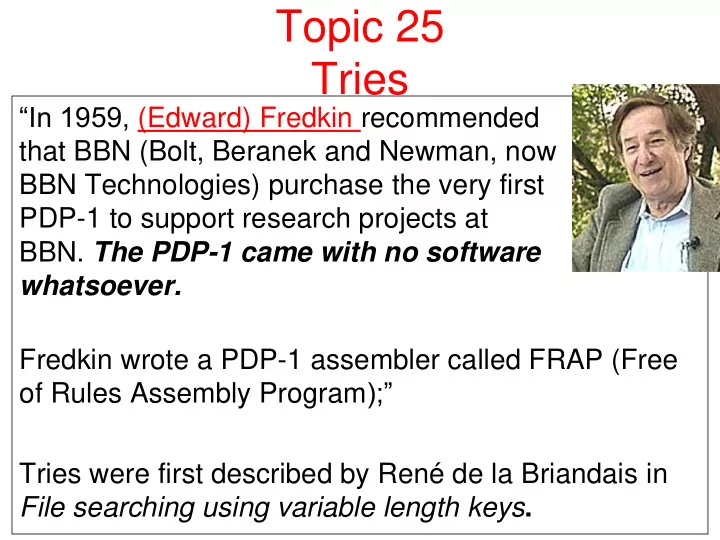

Topic 25 Tries “In 1959, (Edward) Fredkin recommended that BBN (Bolt, Beranek and Newman, now BBN Technologies) purchase the very first PDP-1 to support research projects at BBN. The PDP-1 came with no software whatsoever. Fredkin wrote a PDP-1 assembler called FRAP (Free of Rules Assembly Program );” Tries were first described by René de la Briandais in File searching using variable length keys .
Clicker 1 How would you pronounce “Trie” A. “tree” B. “tri – ee ” C. “try” D. “tiara” E. something else CS314 Tries 2
Tries aka Prefix Trees Pronunciation: From re trie val Name coined by Computer Scientist Edward Fredkin Retrieval so “tree” … but that is very confusing so most people pronounce it “try” CS314 Tries 3
Predictive Text and AutoComplete Search engines and texting applications guess what you want after typing only a few characters CS314 Tries 4
AutoComplete So do other programs such as IDEs CS314 Tries 5
Searching a Dictionary How? Could search a set for all values that start with the given prefix. Naively O(N) (search the whole data structure). Could improve if possible to do a binary search for prefix and then localize search to that location. Difficulties if prefix is not actually in the set or dictionary CS314 Tries 6
Tries A general tree Root node (or possible a list of root nodes) Nodes can have many children – not a binary tree In simplest form each node stores a character and a data structure (list?) to refer to its children Stores all the words or phrases in a dictionary. How? CS314 Tries 7
René de la Briandais Original Paper CS314 Tries 8
???? Picture of a Dinosaur CS314 Tries 9
Can CS314 Tries 10
Candy CS314 Tries 11
Fox CS314 Tries 12
Clicker 2 Is “fast” in the dictionary represented by this Trie? A. No B. Yes C. It depends CS314 Tries 13
Clicker 3 Is “fist” in the dictionary represented by this Trie? A. No B. Yes C. It depends CS314 Tries 14
Tries Another example of a Trie Each node stores: – A char – A boolean indicating if the string ending at that node is a word – A list of children CS314 Tries 15
Predictive Text and AutoComplete As characters are entered we descend the Trie … and from the current node … … we can descend to terminators and leaves to see all possible words based on current prefix b, e, e -> bee, been, bees CS314 Tries 16
Tries Stores words and phrases. – other values possible, but typically Strings The whole word or phrase is not actually stored at a single spot. Rather the path in the tree represents the word
Implementing a Trie CS314 Tries 18
TNode Class Basic implementation uses a LinkedList of TNode objects for children Other options? – ArrayList? – Something more exotic? CS314 Tries 19
Basic Operations Adding a word to the Trie Getting all words with given prefix Demo in IDE CS314 Tries 20
Compressed Tries Some words, especially long ones, lead to a chain of nodes with single child, followed by single child: s b e t e i u o l a y o l d p c l r y l k
Compressed Trie Reduce number of nodes, by having nodes store Strings A chain of single child followed by single child (followed by single child … ) is compressed to a single node with that String Does not have to be a chain that terminates in a leaf node – Can be an internal chain of nodes CS314 Tries 22
Original, Uncompressed s b e t e i u o l a y s l d p c l r y l k CS314 Tries 23
Compressed Version s b ell to e id u ck p ar sy y ll 8 fewer nodes compared to uncompressed version s – t – o – c - k CS314 Tries 24
Data Structures Data structures we have studied – arrays, array based lists, linked lists, maps, sets, stacks, queue, trees, binary search trees, graphs, hash tables, red-black trees, priority queues, heaps Most program languages have some built in data structures, native or library Must be familiar with performance of data structures – best learned by implementing them yourself CS314 Heaps 25
Data Structures We have not covered every data structure Heaps http://en.wikipedia.org/wiki/List_of_data_structures
Data Structures deque, b-trees, quad-trees, binary space partition trees, skip list, sparse list, sparse matrix, union-find data structure, Bloom filters, AVL trees, trie, 2-3-4 trees, and more! Must be able to learn new and apply new data structures CS314 Heaps 27
Recommend
More recommend